Are you considering having knee replacement surgery? If yes, please consider these 3 questions: “How does your knee pain affect your lifestyle?” “Are you exhausted from trying various treatments?” and “Do you know about total knee replacement surgery?”
Total knee replacement surgery is one of the most common bone surgeries in the country. It is a surgical procedure whereby the diseased knee joint is replaced with artificial material. Based on research, it found out that TKR procedures performed each year has increased dramatically since the 1970s, and it is increasing between 5 and 17% per year.
The primary goals of TKR are to relieve pain and improve a patient’s physical function and quality of life. However, not everyone with knee pain is a candidate for total knee replacement surgery. Patients eligible for this surgery have:
-
Severe joint pain with weight bearing or motion that compromises functional abilities
-
Extensive destruction of articular cartilage of the knee secondary to advanced arthritis
-
Marked deformity of the knee such as bow-legs or knock-knees.
-
Gross instability or limitation of motion
-
Failure of nonoperative management or a previous surgical procedure
For example, a person whose x-ray shows a severely degenerated knee but who has low functioning at Activities of Daily Living (ADL) ,e.g. bedridden, and can tolerate the knee pain is probably not a good candidate for knee replacement. This is because bedridden patients have low functional level hence their knee problem wouldn’t affect their ADL. In contrast, a person who has a moderately degenerated knee but ADL function is limited due to knee problem and experiences severe pain may be a good candidate for knee replacement.
There are four basic steps in a knee replacement surgical procedure once the incision has been made.
-
Prepare the bone. The arthritis-damaged joint cartilage surfaces at the ends of the femur and tibia are removed along with a small amount of underlying bone.
-
Position the metal implants. The removed cartilage and bone is replaced with metal components that recreate the surface of the joint. The implant for the femur is attached to the prepared end of femur. Once the femur implant is in place, tibia implant is placed on the proximal end of tibia. These metal parts may be cemented or “press-fit” into the bone.
-
Resurface the patella. Depending on the degree of arthritis, the undersurface of the patella (kneecap) is cut and resurfaced with a plastic button. Some surgeons do not resurface the patella, depending upon the case.
-
Insert a spacer. A medical-grade plastic spacer is inserted between the metal components to create a smooth gliding surface. This spacer provides the cushioning effect and reduced friction that was formerly provided by the joint cartilage.
Post-operative scar
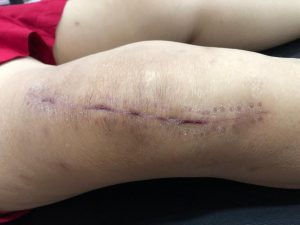
Pre- and Post-Operative Physiotherapy
A proper course of pre- and post-physiotherapy rehabilitation are very important in order to gain the full benefits of surgery. Pre-operative physiotherapy can affect the functional ability before surgery and has relationship with maintaining the level of physical activity after surgery. It can also reduce the occurrence of post-operative complications and achieve the best surgical results. During the hospital stay, physiotherapy right after surgery targets mobilisation and achievement of functional goals relating to hospital discharge. The exercises will help reduce your post-operative pain. Further post-discharge physiotherapy and exercise-based interventions promote retraining and functional improvements.
Exercises (According to time frame)
|
Week |
Goals |
Intervention |
|
Week 1 – Week 4 |
|
|
|
Week 4 – Week 8 |
|
|
|
> Week 8 |
* Range of motion should be 125 degree at this stage. * Should NOT have extension lag. (Normal knee flexion range of motion: 135 degree) |
|
Deep Friction Scar Massage
Rehabilitation Exercises
-
Pelvic Bridging
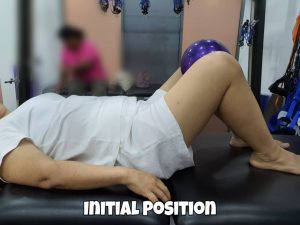
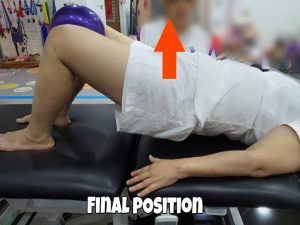
2. Static Quadriceps Exercise
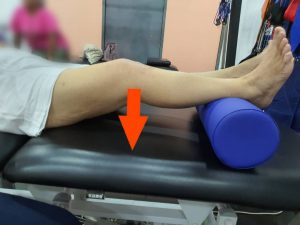
3. Terminal knee extension
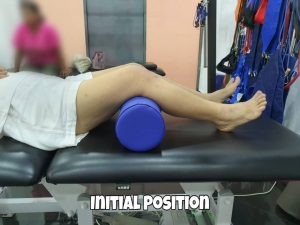
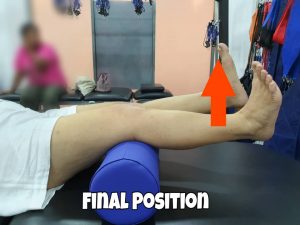
4. Gymball Rolling
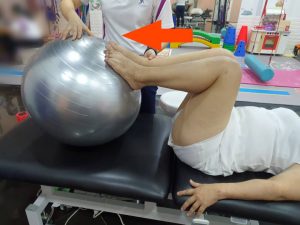
5. Muscle Energy Technique (Hold-Relax)
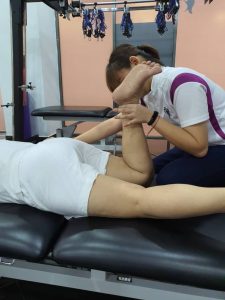
Reference:
-
Singh JA, Vessely MB, Harmsen WS, et al. A population-based study of trends in the use of total hip and total knee arthroplasty, 1969- 2008. Mayo Clin Proc 2010;85:898–904.
-
Kurtz SM, Ong KL, Lau E, Widmer M, Maravic M, Gomez-Barrena E, et al. International survey of primary and revision total knee replacement. Int Orthop. 2011;35(12):1783–9.
